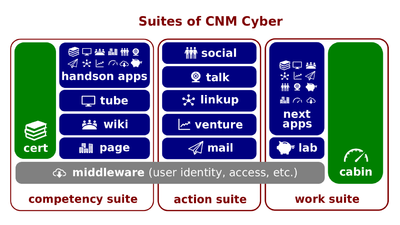Difference between revisions of "Structure of CNM Cloud"
(→Script) |
(→Script) |
||
| Line 8: | Line 8: | ||
===Script=== | ===Script=== | ||
| − | :[[CNM Cloud]] is designed | + | :[[CNM Cloud]] is designed according to the [[service-oriented architecture]] ([[SOA]]) concept. Its [[software system]]s are discrete, but feature simple and well-defined interfaces, so they can be orchestrated to work together if needed. |
:[[CNM Cloud Foundation]], [[WorldOpp Middleware]], and [[CNM app]]s form the structure of [[CNM Cloud]]. | :[[CNM Cloud Foundation]], [[WorldOpp Middleware]], and [[CNM app]]s form the structure of [[CNM Cloud]]. | ||
| − | : | + | :[[CNM app]]s are most visible parts of [[CNM Cloud]]. However, these [[end-user application]]s require their environment and orchestration. |
| − | : | + | :[[CNM Cloud Foundation]] is the basis of this environment; the ''Foundation'' provides functionality for both the ''apps'' and the ''Middleware''. The environment includes its [[operating system]]s, [[web server]]s, [[database management system]]s, and support for [[programming language]]s. |
| − | :The ''Middleware'' provides [[CNM app]]s with those services that are central for the ''Cloud'' and cannot be provided by | + | :[[WorldOpp Middleware]] is used for orchestration. The ''Middleware'' provides [[CNM app]]s with those services that are central for the ''Cloud'' and cannot be provided by the ''Foundation''. Particularly, the ''Middleware'' handles user permissions and rights throughout the whole ''Cloud.'' |
'''[[Available vs Custom Code]]''' is the successor [[lectio]]. | '''[[Available vs Custom Code]]''' is the successor [[lectio]]. | ||
Revision as of 03:09, 23 September 2020
Structure of CNM Cloud (hereinafter, the Lectio) is the lesson part of the CNM Cloud Essentials lesson that introduces its participants to CNM Cloud. This lesson belongs to the Introduction to CNM Cloud session of the CNM Cyber Orientation.
Contents
Content
The predecessor lectio is CNM App Groups.
Key terms
Script
- CNM Cloud is designed according to the service-oriented architecture (SOA) concept. Its software systems are discrete, but feature simple and well-defined interfaces, so they can be orchestrated to work together if needed.
- CNM Cloud Foundation, WorldOpp Middleware, and CNM apps form the structure of CNM Cloud.
- CNM apps are most visible parts of CNM Cloud. However, these end-user applications require their environment and orchestration.
- CNM Cloud Foundation is the basis of this environment; the Foundation provides functionality for both the apps and the Middleware. The environment includes its operating systems, web servers, database management systems, and support for programming languages.
- WorldOpp Middleware is used for orchestration. The Middleware provides CNM apps with those services that are central for the Cloud and cannot be provided by the Foundation. Particularly, the Middleware handles user permissions and rights throughout the whole Cloud.
Available vs Custom Code is the successor lectio.
Questions
Lectio quiz
- The answer is recorded for the lectio completion purpose:
- CNM Cabin is hosted by:
- CNM Cloud Next
- WorldOpp Federated Servers
- CNM Fellow Servers
- CNM HandsOn Servers
- None of the other answers is correct.
- Which statement below is correct:
- CNM Cyber may include three identical CNM apps.
- While taking this course, you work on the CNM Fellow Servers.
- Future administrators of CNM apps get hands-on training at the CNM Cloud Next.
- All of the other substantive answers are correct.
- None of the other answers is correct.
- CNM Cabin is hosted by:
Placement entrance exam
True/False questions
- CNM Cloud Foundation has (does not have) four groups of servers.
- (wlcm-cloud-00003) Each of CNM Cyber's services is (not) powered by CNM app.
- (wlcm-cloud-00006) CNM Cloud Next hosts systems used in hands-on training.
- (wlcm-cloud-00008) CNM HandsOn Servers is (not) designed to be used for training of CNM Cloud administrators and their experiments.
- CNM Cloud Foundation is (not) the combination of computing servers that host CNM Cloud.
- CNM Cloud Foundation is (not) the combination of computing servers.
- WorldOpp Federated Servers (do not) host WorldOpp Middleware and its software applications.
- Federated Server (does not) host CNM Cabin.
- WorldOpp Federated Server (does not) host CNM Cabin.
- CNM HandsOn Apps are (not) installed on the CNM HandsOn Servers.
- CNM HandsOn Servers are (not) used for the hands-on training of CNM Cyber service administrators.
- WikiHandsOn, TubeHandsOn, and MailHandsOn are (not) the examples of CNM HandsOn Apps.
- CNM Next Apps are (not) installed on CNM Cloud Next.
- CNM Next Apps are (not) installed on WorldOpp Federated Servers.
- CNM Next Apps are (not) installed on CNM HandsOn Servers.
- CNM Cloud Next are (not) used for the experiential learning of CNM Cloud administrators.
- CNM HandsOn Servers are (not) used for the experiential learning of CNM Cloud administrators.
Fill-in-blanks (short answer) questions
- CNM Cabin is hosted by _______ Server.
- CNM Next Apps are installed on CNM _______Servers.
- CNM _________Apps are installed on CNM Cloud Next.
- CNM ____________ Servers are used for the experiential learning of CNM Cloud administrators.
- WikiHandsOn, TubeHandsOn, and MailHandsOn are the examples of CNM __________ Apps.
- For hands-on training during CNM Cyber Placement, you will be using CNM _________ Apps.
- CNM Cyber ___________ is the combination of computing servers that host CNM Cloud.
- Last, but not least, all the other CNM apps are installed on the CNM Fellow Servers.
- CNM Cert is installed on CNM _________ Server.
- CNM Page is installed on CNM _________ Server.
- CNM Wiki is installed on CNM _________ Server.
- CNM Tube is installed on CNM _________ Server.
- All the apps of the CNM Action Suite are installed on CNM __________ Server.
